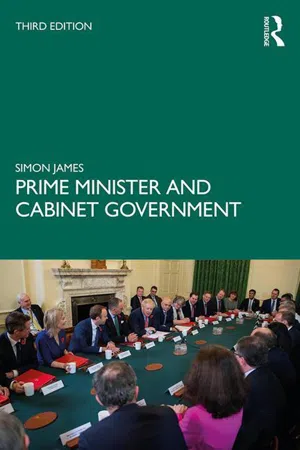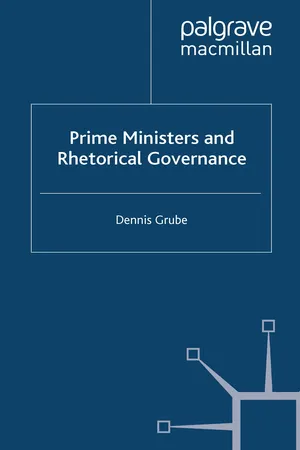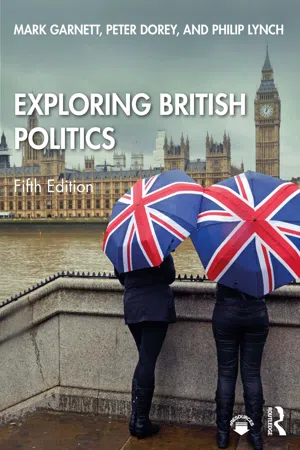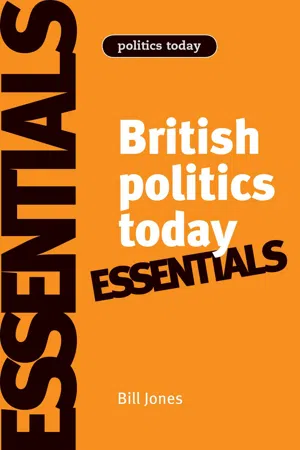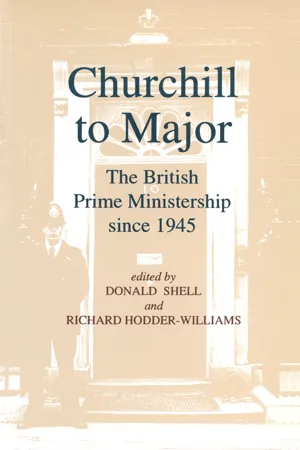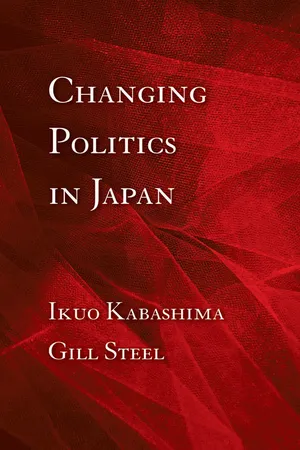Politics & International Relations
Prime Minister
The Prime Minister is the head of government in a parliamentary system, responsible for leading the executive branch and implementing policies. They are typically the leader of the majority party in the legislature and are appointed by the head of state. The Prime Minister holds significant decision-making power and is a key figure in shaping a country's domestic and foreign policies.
Written by Perlego with AI-assistance
Related key terms
6 Key excerpts on "Prime Minister"
- eBook - ePub
- Simon James(Author)
- 2020(Publication Date)
- Routledge(Publisher)
Ever since the office of Prime Minister came into existence three centuries ago, foreign affairs have constituted a large part of the workload. Since 1945 this has grown considerably, and has similarly affected heads of government around the world. A revolution in communications allows politicians to travel faster and more frequently, and to speak to each other instantly, leading to more regular bilateral conversations between world leaders and the growth of international summitry. Second, the character of international relations has broadened to include a great range of military, economic, security and environmental issues, whose cross-governmental nature tends to draw in the head of government. Third, membership of the EU made many areas of domestic policy the subject of international action and so brought them to the European Council, the EU’s meeting of heads of government, fuelling the general practice of summitry; Brexit notwithstanding, discussion of these issues at head of government level is now a matter of habit for European leaders. International relations are examined at greater length in Chapter 5 ; the point of immediate importance is that they constitute a large part of the Prime Minister’s functions and take up a lot of time. Primus inter pares, presidentialism and conflict with ministers Given those functions, and particularly the right to intervene in policy areas, what leverage does the Prime Minister exercise within the system? Here we have to clear out of the way three misconceptions that bedevil the study of British central government. The first is the confusion caused to students by the familiar phrase primus inter pares (first among equals) – used, especially by politicians, to encapsulate their constitutional ideal of the Prime Minister as only the most senior of a collective of colleagues. It is neither an accurate nor an adequate summary of the premier’s position - eBook - ePub
- D. Grube(Author)
- 2015(Publication Date)
- Palgrave Macmillan(Publisher)
In essence, the core roles played by the rhetorical Prime Minister mirror the different political or governing roles a Prime Minister plays in the polity. In other words, a central claim here is that each distinct ‘public’ duty of a Prime Minister has an accompanying rhetorical role which has to be carried out in order for the duty to be effectively met. To develop these categories of rhetorical action, I build on analytical studies of the Prime Ministership in Britain and Australia that have attempted to set out some of the duties of a Prime Minister. It is a task fraught with difficulty. As extensive scholarly debates on the idea of the ‘core executive’ (see Dunleavy and Rhodes, 1990; Elgie, 2011) and on the ‘presidentialisation’ of Prime Ministers (see for example Foley, 1993, 2000; Bevir and Rhodes, 2006) have shown, there is no one dominant understanding of what it is that Prime Ministers actually do.Shell (1995) identifies and distinguishes between the three core roles of ‘head of government’, ‘party leader’ and ‘national leader’. Weller and other contributing authors (1992) and the contributing authors to Shell and Hodder-Williams’ edited collection (1995) also bring out the role of the Prime Minister within the cabinet, in international relations, with the media, within the parliament and in dealing with the public service. Peter Hennessy’s seminal work lists a range of more specific responsibilities, including constitutional requirements and appointment powers (2000, pp. 53–101). All of these studies agree on the contextual nature of Prime Ministerial power and the degree of personal choice that remains for each leader in the amount of time they will attach to each activity that they undertake. Richard Heffernan’s important body of work on the topic suggests that Prime Ministers have a central role in ‘developing workable policies, winning elections, managing the government and working with and through other actors in both government and parliament and at home and abroad’ (Heffernan, 2005, p. 606).Here, I focus on categories of action in which Prime Ministers have a public rhetorical responsibility. In other words, the roles in which they are expected to provide some kind of rhetorical lead through their public appearances. This excludes from this study much of what occurs in cabinet, or in relationships with the monarch, advisers and bureaucrats, which necessarily happen behind closed doors. The focus is also on public roles outside of the parliament, rather than appearances within the parliament itself. The rhetorical Prime Ministership’s development as an extra-parliamentary institution has been central to its evolution. - eBook - ePub
- Mark Garnett, Peter Dorey, Philip Lynch(Authors)
- 2020(Publication Date)
- Routledge(Publisher)
4. Public profile High public profile Communicator-in-chief for the governmentSpeaks for nation in times of crisisRepresents UK on world stagePoor response to crisis undermines authorityMay become focus of media criticismUnpopularity weakens loyalty of MPs/ministers, who fear electoral defeat, and loss of their own seats5. Policymaking input Directs government policy and sets agendaHas authority to get involved in any policy areaPolitical rewards of policy successLacks time and detailed knowledge Lacks resources provided by a specific government departmentMay be personally associated with failure of a key policy6. Prime Minister’s Office Provides independent advice and supportHelps PM to direct policyPrime Minister’s Office has limited resourcesOther departments have own interestsAppointing more advisers also means more staff to manage, and more scope for conflicting adviceSource: Adapted from M. Garnett and P. Lynch, AS UK Government and Politics (Deddington: Philip Allan Updates, 2nd edition, 2005), pp. 271–73; P. Dorey, Policy Making in Britain (London: Sage, 2nd edition, 2014), p. 76; M.J. Smith, The Core Executive in Britain (Basingstoke: Palgrave Macmillan, 1999), p. 32.- powers of patronage
- the authority of the office
- party leadership
- public standing
- policymaking input
- the Prime Minister’s Office
- the Cabinet Office.
Patronage
The Prime Minister was previously charged with making a range of Crown and public appointments, including senior positions within the civil service, military, intelligence and security services, judiciary, and Church of England, plus various positions in the public sector, and chairs of key committees of inquiry (e.g. the Hutton and Leveson Inquiries (see Chapter 5 - eBook - ePub
British politics today: Essentials
6th Edition
- Bill Jones, Dennis Kavanagh(Authors)
- 2013(Publication Date)
- Manchester University Press(Publisher)
• The electronic media in particular have turned the head of government into a household figure nationwide; in the nineteenth century, the Prime Minister might have been well known but few would have heard him speak – as the nation heard Baldwin in his regular broadcasts or Churchill during the war – or indeed have seen him; in contrast, the nation regularly saw Margaret Thatcher and Tony Blair at Prime Minister’s Questions and while traversing the world on diplomatic business. Even if they resisted the idea, the media have made Prime Ministers better-known than the biggest film stars; their lives, actions and even families are scrutinised and dissected by reporters and commentators every minute of the day. Even if Prime Ministers were not wholly in charge of their governments, their media profile generally made it appear as if they were.• The phenomenon of powerful Prime Ministers in the latter part of the twentieth century pushed forward the limits of Prime Ministerial power to an even greater extent. Margaret Thatcher and Tony Blair are the two most obvious examples (see below on their styles of governing).What roles does the Prime Minister perform?
Any Prime Minister has to take on a variety of roles in an exhausting job (see Table 13.1 ). Note, though, that despite being the main driving force of policy and, in Blair’s case, the person who took the country to war on several occasions, the Prime Minister is not the Commander in Chief of the armed forces, as the US President is.Head of the executive
• Like the US President, Prime Ministers have to head up the government of the day. They have to appoint members of Cabinet and other ministers. Unlike the President, they are limited in this recruitment to the pool of Members of both Houses of Parliament. Likewise, they have to remove members when necessary and ‘reshuffle the pack’ to maintain freshness and competence in the Cabinet team. - eBook - ePub
Churchill to Major: The British Prime Ministership since 1945
The British Prime Ministership since 1945
- R.L. Borthwick, Martin Burch, Philip Giddings(Authors)
- 2016(Publication Date)
- Routledge(Publisher)
At the heart of any explanation of this apparent paradox is the constitutional system itself. The British system remains obstinately parliamentary, not presidential. The precise style and form which it takes may have changed over the years, but its central principles have not. Parliament may not be a collective body which initiates laws or arbitrates upon laws presented to it by the executive (and it probably never has been), and in this it remains a pale image of the Fourth French Republic’s National Assembly or the American Congress. Furthermore, the growth of the visual media and the access of television to the Houses of Parliament have widened the political community whose views and actions affect public life. At first sight, it might seem that Parliament’s importance has declined. But it should never be forgotten that Parliament, or the House of Commons to be more accurate, continues to provide the legitimation for governments, the parliamentary party which gives – or takes away – support for the executive, and the chamber which provides the crucible in which reputations are forged. (The vision offered by Colin Seymour-Ure of a party leader whose reputation is built upon media skills rather than parliamentary support, for which Italy may provide an early illustration, has not yet been realised; but politicians vying for position are more conscious than ever before of their performance and image in the media.) Prime Ministers, of course, need the national electorate in order for them and their parties to be placed in power; but it is Parliament which made them leaders and can end their tenures, even at moments when the party activists in the country might prefer otherwise.It must be emphasised that Prime Ministers have no formal political bases of their own. The central institution, in terms of power, remains Parliament. Presidents by contrast have usually been elected, and then proceed to exercise power, in their own democratic right. Prime Ministers are merely MPs who have the temporary and, be it noted, the voluntary support of their parties to be leader; they have no legally based right to the position and can find that support withdrawn. More than this, although colleagues may owe their specific positions within the government to the Prime Minister, they not only have an equal legitimacy as MPs and often personal support of their own within the party, but they have also shared common experiences and, of particular importance, the responsibility for common policies with the Prime Minister. During the initial period in office, Prime Ministers have little room for policy manoeuvre because they are committed, as are their colleagues, to past positions, and those who come into power replacing party colleagues inherit the future promises set out in the most recent manifesto. Prime Ministers are, in effect, captains of their teams, but they owe their position (and its very real powers) not to a manager or outside directors but to the team itself. - eBook - ePub
- Ikuo Kabashima, Gill Steel(Authors)
- 2012(Publication Date)
- Cornell University Press(Publisher)
5CITIZENS AND THE PRIME MINISTER
Studies in political science often describe citizens as uninvolved in politics, seeing them as passive spectators rather than active participants in the political process (Hrebenar 2000, chap. 1). During the 1955 system, when people did engage in politics, it was in clientelistic relations at the local level, with politicians providing patronage to their districts and constituents reciprocating with their votes on election day. National-level politics and who the Prime Minister happened to be mattered little. Before the 1980s, for the general public, the Prime Minister’s role and image was indistinct from support for the ruling party (Krauss and Nyblade 2004). The few academic studies of the Japanese Prime Minister’s role describe the position as weak, constrained by informal power structures, lacking in formal resources (Krauss and Nyblade 2004, 358), and less important than the role of Prime Ministers in other countries. So it is hardly surprising that the general feeling in Japan was that Prime Ministers were fairly unimportant.However, the resources of Prime Ministers and the options available to them have increased (see chapter 6), and citizen oversight of the Prime Minister has grown. Correspondingly, Krauss and Nyblade show that the importance of the public image of the Prime Minister has grown significantly in the past few decades (Krauss and Nyblade 2004).Citizens generally have had more control over the Prime Minister than some accounts of politics accord them—pundits generally believe that Prime Ministers must resign if their approval rate falls below a certain threshold. As Masuzoe Yoichi (2000), a former assistant professor at the University of Tokyo, sometime LDP cabinet minister, and very frequent TV guest puts it, “In general, a support rate of under 30% is considered a yellow light for a Japanese Prime Minister, and a rate of under 20% is considered a red light.”
Index pages curate the most relevant extracts from our library of academic textbooks. They’ve been created using an in-house natural language model (NLM), each adding context and meaning to key research topics.
